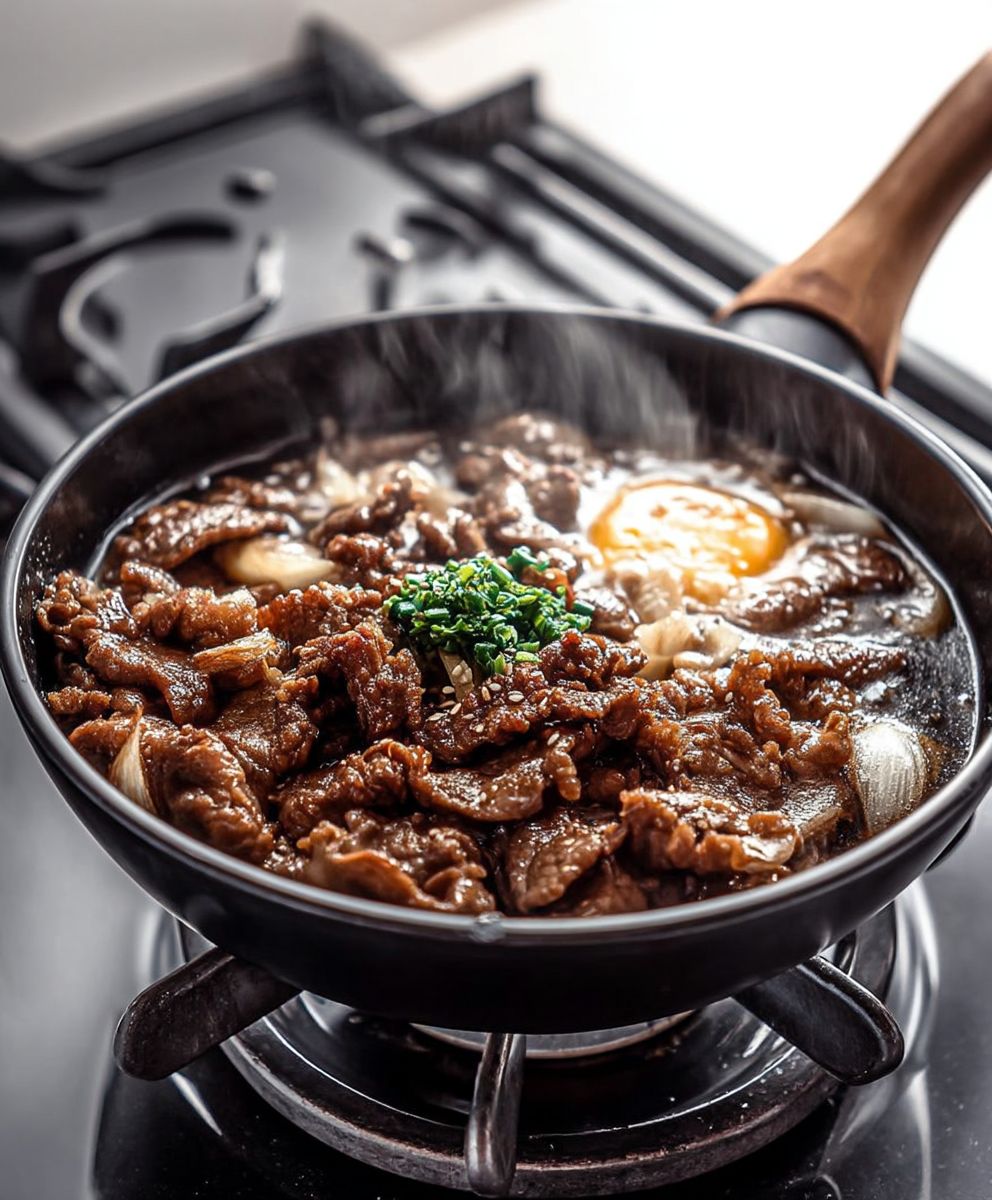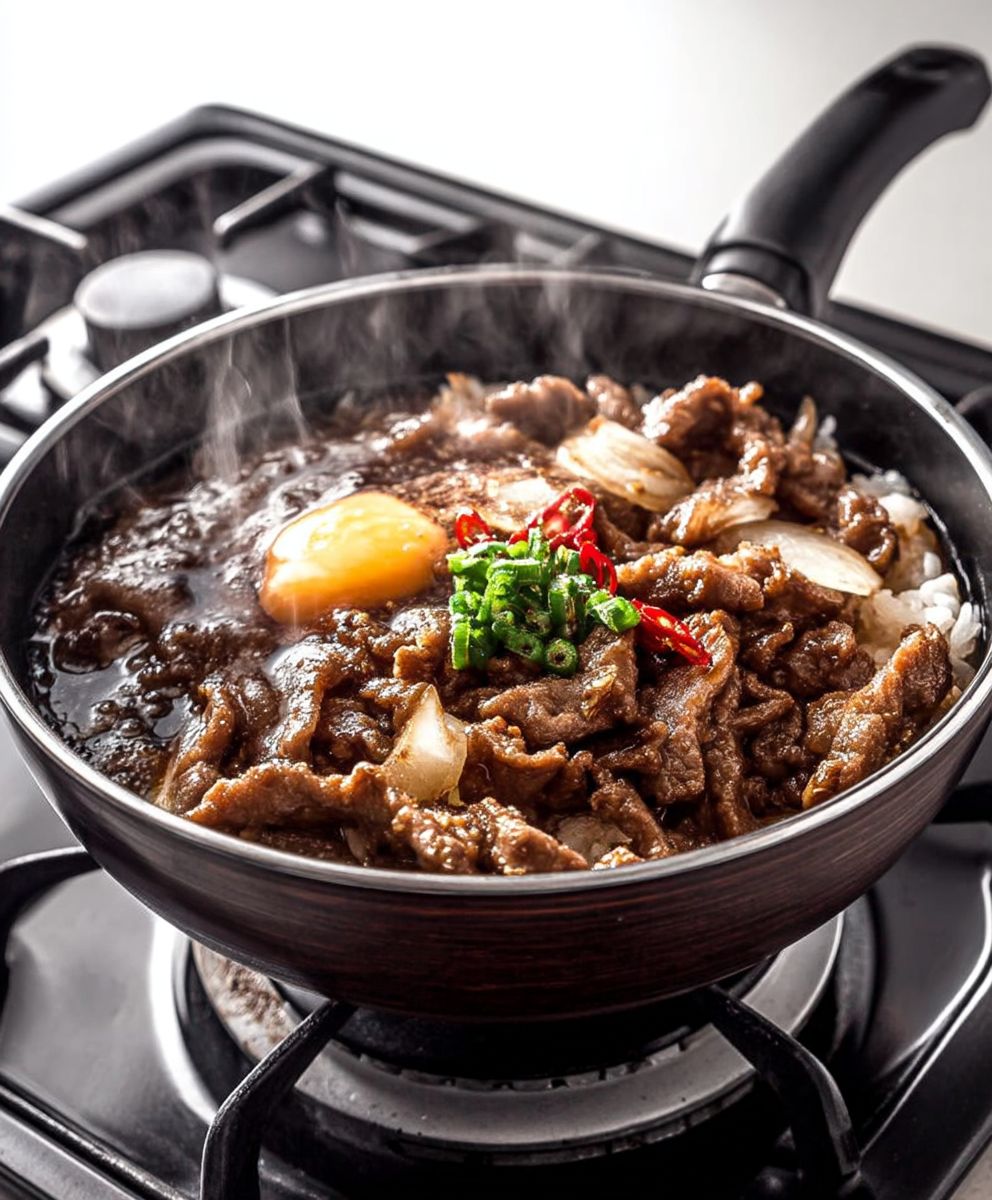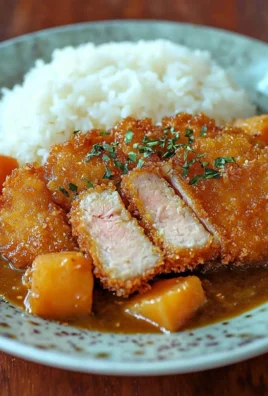Yoshinoya Gyudon, that iconic Japanese beef bowl, is a dish that has captured hearts (and stomachs!) worldwide. Imagine tender, thinly sliced beef simmered in a savory-sweet sauce, blanketing a fluffy bed of rice. It’s comfort food at its finest, and today, I’m thrilled to share my version of this beloved classic with you.
The history of Yoshinoya Gyudon is intertwined with the story of Japan’s rapid modernization. Originating in Tokyo’s fish market in the late 19th century, Gyudon was a quick and affordable meal for busy workers. Yoshinoya, the restaurant chain that popularized the dish, played a significant role in making it a national staple. It’s more than just a meal; it’s a taste of Japanese history and a symbol of efficient, delicious dining.
But what makes Gyudon so irresistible? It’s the perfect balance of flavors the umami-rich beef, the subtly sweet and salty sauce, and the satisfying texture of the rice. It’s also incredibly convenient, making it a go-to option for a quick lunch or a satisfying dinner. Whether you’re a seasoned foodie or a beginner in the kitchen, this recipe is surprisingly easy to master. Get ready to experience the magic of Gyudon in your own home!
Ingredients:
- 1.5 lbs thinly sliced beef (ribeye or sirloin work best)
- 1 large onion, thinly sliced
- 4 cups cooked Japanese short-grain rice, hot
- 4 large eggs (optional, for onsen tamago or soft boiled eggs)
For the Sauce (Warishita):
- 1 cup water
- 1/2 cup soy sauce
- 1/4 cup mirin
- 2 tablespoons sake
- 1 tablespoon sugar
- 1 teaspoon grated ginger (optional)
Optional Toppings:
- Pickled ginger (beni shoga)
- Seven spice pepper (shichimi togarashi)
- Green onions, thinly sliced
Preparing the Sauce (Warishita):
This is the heart of the Gyudon, so let’s get it right! The Warishita is a sweet and savory sauce that infuses the beef and onions with that signature Yoshinoya flavor. Don’t skip this step!
- In a medium saucepan, combine the water, soy sauce, mirin, sake, sugar, and grated ginger (if using).
- Bring the mixture to a simmer over medium heat. Stir gently to ensure the sugar dissolves completely.
- Once simmering, reduce the heat to low and let it simmer for about 5-7 minutes. This allows the flavors to meld together and the sauce to thicken slightly. You’re not looking for a thick sauce, just a slightly richer consistency.
- Taste the sauce and adjust the sweetness or saltiness to your preference. If it’s too salty, add a splash more water. If it’s not sweet enough, add a tiny bit more sugar. Remember, you can always add more, but you can’t take it away!
- Remove the saucepan from the heat and set the sauce aside.
Cooking the Beef and Onions:
Now for the main event! This part is quick and easy, so have your rice ready to go.
- Heat a large skillet or wide-bottomed pot over medium-high heat. A wide pan is important so the beef cooks evenly and doesn’t steam.
- Add the thinly sliced onions to the skillet and cook, stirring occasionally, until they become translucent and slightly softened. This should take about 5-7 minutes. You want them to be soft, but not browned.
- Pour the prepared Warishita sauce over the onions. Bring the sauce to a simmer.
- Carefully add the thinly sliced beef to the skillet, spreading it out evenly over the onions and sauce. Try not to overcrowd the pan; you may need to cook the beef in batches if your skillet isn’t large enough. Overcrowding will lower the temperature and cause the beef to steam instead of simmer, which will affect the texture.
- Cook the beef, gently separating the slices with chopsticks or a fork, until it is cooked through and no longer pink. This should only take about 2-3 minutes. Be careful not to overcook the beef, as it will become tough. You want it to be tender and juicy.
- As the beef cooks, it will release some juices, which will further flavor the sauce. Let the sauce simmer for another minute or two to allow the flavors to meld together.
- Taste the sauce again and adjust the seasoning if necessary. You might want to add a little more soy sauce for saltiness or a pinch of sugar for sweetness.
Assembling the Gyudon:
The final step! This is where all your hard work pays off. Get ready to enjoy a delicious bowl of Gyudon.
- Divide the hot cooked rice evenly among four bowls.
- Spoon the beef and onion mixture generously over the rice in each bowl. Make sure to get plenty of the flavorful sauce!
- If you’re making onsen tamago (soft poached egg), gently place one on top of each bowl of Gyudon. The runny yolk adds a richness and creaminess that is simply divine.
- Alternatively, you can make soft boiled eggs. Cook eggs in boiling water for 6-7 minutes, then immediately transfer them to an ice bath to stop the cooking process. Peel the eggs and slice them in half before placing them on top of the Gyudon.
- Garnish with pickled ginger (beni shoga), seven spice pepper (shichimi togarashi), and thinly sliced green onions, if desired. These toppings add a pop of color and flavor that really elevates the dish.
- Serve immediately and enjoy!
Tips and Variations:
Want to customize your Gyudon? Here are a few ideas:
- Add Tofu: For a vegetarian option, you can add firm tofu, cut into cubes, to the skillet along with the onions.
- Spice it Up: Add a pinch of red pepper flakes to the sauce for a little heat.
- Use Different Cuts of Beef: While ribeye and sirloin are traditional, you can also use other thinly sliced cuts of beef, such as chuck or flank steak. Just be sure to adjust the cooking time accordingly.
- Make it Healthier: Use brown rice instead of white rice for a more nutritious meal. You can also reduce the amount of sugar in the sauce.
- Add Vegetables: Feel free to add other vegetables to the skillet along with the onions, such as mushrooms, carrots, or bell peppers.
- Onsen Tamago Alternative: If you don’t have time to make onsen tamago, you can use a store-bought poached egg or even a fried egg.
Making Onsen Tamago (Optional):
Onsen Tamago, or hot spring eggs, are a traditional Japanese egg preparation where the eggs are cooked at a low temperature, resulting in a custardy white and a runny yolk. They are the perfect addition to Gyudon!
- Prepare the Water Bath: You’ll need a pot or container that can hold enough water to fully submerge the eggs. The ideal temperature is around 140-149°F (60-65°C). You can use a sous vide machine for precise temperature control, or you can use a thermometer and adjust the heat on your stovetop.
- Heat the Water: Heat the water to the desired temperature. If using a stovetop, bring the water to a simmer and then turn off the heat. Let the water cool slightly until it reaches the target temperature.
- Add the Eggs: Gently lower the eggs into the water bath. You can use a slotted spoon to prevent them from cracking.
- Cook the Eggs: Cook the eggs for 13-15 minutes. The exact cooking time will depend on the size of the eggs and the temperature of the water.
- Cool the Eggs: After cooking, carefully remove the eggs from the water bath and immediately place them in an ice bath to stop the cooking process.
- Peel the Eggs: Gently crack the eggs and peel them under cold running water. The whites will be very delicate, so be careful not to break them.
- Serve: Place the onsen tamago on top of your Gyudon and enjoy!
Serving Suggestions:
Gyudon is a complete meal on its own, but here are a few side dishes that would complement it nicely:
- Miso Soup: A classic Japanese soup made with fermented soybean paste.
- Japanese Pickles (Tsukemono): A variety of pickled vegetables, such as daikon radish, cucumber, or cabbage.
- Edamame: Steamed soybeans in the pod, sprinkled with salt.
- Seaweed Salad: A refreshing salad made with seaweed, sesame oil, and soy sauce.
Storage Instructions:
If you have any leftover Gyudon, you can store it in the refrigerator for up to 3 days. Store the beef and onion mixture separately from the rice to prevent the rice from becoming soggy.
To reheat, simply microwave the beef and onion mixture until heated through. You can also reheat it in a skillet over medium heat. Reheat the rice separately in the microwave or in a rice cooker.
I hope you enjoy this recipe for Yoshinoya Gyudon! It’s a quick, easy, and delicious meal that is sure to become a family favorite.

Conclusion:
So there you have it! This Yoshinoya Gyudon recipe isn’t just another beef bowl; it’s a passport to authentic Japanese comfort food, right in your own kitchen. I truly believe that once you’ve tasted the sweet and savory perfection of thinly sliced beef simmered in that irresistible sauce, you’ll understand why this dish is a global phenomenon. It’s quick, it’s easy, and it’s guaranteed to satisfy even the most discerning palate.
But why is this recipe a must-try? Beyond the incredible flavor profile, it’s the sheer versatility and accessibility that makes it a winner. Forget complicated techniques or hard-to-find ingredients. This recipe uses readily available items, and the cooking process is straightforward enough for even a beginner cook to master. Plus, it’s a fantastic way to impress your friends and family with a restaurant-quality meal without breaking the bank.
Now, let’s talk serving suggestions and variations! While a classic bowl of Gyudon served over a bed of fluffy white rice is undeniably divine, there are countless ways to customize it to your liking. For a richer flavor, try adding a dollop of Japanese mayonnaise or a sprinkle of toasted sesame seeds. If you’re feeling adventurous, consider topping it with a soft-boiled egg for that extra creamy goodness. The runny yolk will coat the beef and rice, creating an unbelievably decadent experience.
Vegetable lovers, rejoice! You can easily add your favorite veggies to the simmering pot. Sliced onions are a must, of course, but feel free to throw in some mushrooms, carrots, or even spinach for added nutrients and texture. For a spicier kick, add a pinch of red pepper flakes or a drizzle of sriracha. And if you’re watching your carb intake, you can serve the Gyudon over cauliflower rice or even zucchini noodles for a healthier alternative.
Don’t be afraid to experiment and make this recipe your own! That’s the beauty of cooking it’s all about creativity and personal expression. Try different cuts of beef, adjust the sweetness of the sauce, or add your own unique twist. The possibilities are endless!
I’m so confident that you’ll love this Yoshinoya Gyudon recipe that I urge you to try it out as soon as possible. Gather your ingredients, put on some upbeat music, and get ready to embark on a culinary adventure. And most importantly, don’t forget to have fun!
Once you’ve made this delicious dish, I would absolutely love to hear about your experience. Did you make any modifications? What did you think of the flavor? Did your family and friends enjoy it? Share your thoughts, photos, and tips in the comments below. Your feedback is invaluable, and it helps me to continue creating recipes that you’ll love.
So go ahead, give this recipe a try and discover the magic of authentic Japanese cuisine. I promise you won’t be disappointed! Happy cooking! I can’t wait to hear all about your Gyudon creations. Let me know if you have any questions, and I’ll do my best to help. Enjoy!
Yoshinoya Gyudon: The Ultimate Guide to Japan's Beef Bowl
Quick and easy Yoshinoya-style Gyudon (Japanese Beef Bowl) with thinly sliced beef, savory-sweet sauce, and tender onions served over hot rice. Optional onsen tamago (soft poached egg) takes it to the next level!
Ingredients
- 1. 5 lbs thinly sliced beef (ribeye or sirloin work best)
- 1 large onion, thinly sliced
- 4 cups cooked Japanese short-grain rice, hot
- 4 large eggs (optional, for onsen tamago or soft boiled eggs)
- 1 cup water
- 1/2 cup soy sauce
- 1/4 cup mirin
- 2 tablespoons sake
- 1 tablespoon sugar
- 1 teaspoon grated ginger (optional)
- Pickled ginger (beni shoga)
- Seven spice pepper (shichimi togarashi)
- Green onions, thinly sliced
Instructions
- Prepare the Sauce (Warishita): In a medium saucepan, combine water, soy sauce, mirin, sake, sugar, and grated ginger (if using). Bring to a simmer over medium heat, stirring until sugar dissolves. Reduce heat to low and simmer for 5-7 minutes to meld flavors and slightly thicken. Taste and adjust sweetness/saltiness as needed. Remove from heat and set aside.
- Cook the Beef and Onions: Heat a large skillet or wide-bottomed pot over medium-high heat. Add onions and cook, stirring occasionally, until translucent and softened (5-7 minutes). Pour Warishita sauce over onions and bring to a simmer.
- Carefully add the thinly sliced beef to the skillet, spreading it out evenly over the onions and sauce. Try not to overcrowd the pan; you may need to cook the beef in batches if your skillet isn’t large enough. Overcrowding will lower the temperature and cause the beef to steam instead of simmer, which will affect the texture.
- Cook the beef, gently separating the slices with chopsticks or a fork, until it is cooked through and no longer pink. This should only take about 2-3 minutes. Be careful not to overcook the beef, as it will become tough. You want it to be tender and juicy.
- As the beef cooks, it will release some juices, which will further flavor the sauce. Let the sauce simmer for another minute or two to allow the flavors to meld together.
- Taste the sauce again and adjust the seasoning if necessary. You might want to add a little more soy sauce for saltiness or a pinch of sugar for sweetness.
- Assemble the Gyudon: Divide hot rice among four bowls. Spoon beef and onion mixture generously over rice. Top with onsen tamago or soft boiled egg (optional). Garnish with pickled ginger, seven spice pepper, and green onions (optional). Serve immediately.
- For Onsen Tamago (Optional): Prepare a water bath at 140-149°F (60-65°C). Gently lower eggs into the water bath and cook for 13-15 minutes. Immediately transfer to an ice bath to stop cooking. Gently peel under cold running water.
Notes
- For a vegetarian option, add firm tofu, cut into cubes, to the skillet along with the onions.
- Add a pinch of red pepper flakes to the sauce for a little heat.
- While ribeye and sirloin are traditional, you can also use other thinly sliced cuts of beef, such as chuck or flank steak. Just be sure to adjust the cooking time accordingly.
- Use brown rice instead of white rice for a more nutritious meal. You can also reduce the amount of sugar in the sauce.
- Feel free to add other vegetables to the skillet along with the onions, such as mushrooms, carrots, or bell peppers.
- If you don’t have time to make onsen tamago, you can use a store-bought poached egg or even a fried egg.
- Store leftovers separately in the refrigerator for up to 3 days. Reheat beef/onion mixture in microwave or skillet. Reheat rice separately.
- Serving Suggestions: Miso Soup, Japanese Pickles (Tsukemono), Edamame, Seaweed Salad.




